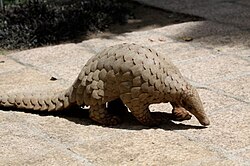இந்திய அலங்கு
| இந்திய அலங்கு | |
|---|---|

| |
| இலங்கையில் ஒரு எறும்புண்ணி | |
| உயிரியல் வகைப்பாடு | |
| திணை: | |
| தொகுதி: | |
| வகுப்பு: | |
| வரிசை: | Pholidota
|
| குடும்பம்: | Manidae
|
| பேரினம்: | Manis
|
| இனம்: | M. crassicaudata
|
| இருசொற் பெயரீடு | |
| Manis crassicaudata E. Geoffroy, 1803 | |
இந்திய அலங்கு அல்லது இந்திய எறும்புண்ணி (Manis crassicaudata) என்பது ஒரு எறும்புண்ணி ஆகும். இது இந்தியா, இலங்கை, நேபாளம், பூடான் ஆகிய நாடுகளின் சமவெளிகள், மலைகள் போன்ற இடங்களில் காணப்படுகிறது.[2] இது பூனை அளவு கொண்டதாகவும், ஆனால் சற்றே நீளமான உடலும், நீண்ட வாலும், கூர்மையான முகம் கொண்ட, கூரிய நுண்ணறிவுள்ள விலங்கு ஆகும். மற்ற பாலூட்டிகள் போலல்லாமல் இதன் உடல் முழுக்க உள்ள செதில்கள் இதற்கு பாதுகாப்பு கவசமாகப் பயன்படுகிறது. உடலில் உள்ள முடிகளே காலப்போக்கில் செதில்களாக மாறிவிட்டன. பிற விலங்குகளிடமிருந்து தன்னை தற்பாதுகாக்க ஒரு இரும்பு குண்டு போல தன்னை சுருட்டிக்கொள்ள இதனால் முடியும். இதற்கு நல்ல உடல் வலு இருப்பதால் சுருட்டிக்கொண்ட உடலை இயல்பான நிலைக்கு விரிப்பது நம்மால் இயலாத செயல்.இதன் செதில்கள் நிறம் இதன் வாழும் சூழலில் பூமியின் நிறம் பொறுத்து மாறுபடுகிறது.[3] இது பகலில் நிலத்தடி வங்குகளிலும் பாறை இடுக்குகளிலும், மரபொந்துகளிலும் சுருண்டு உறங்கும். இருட்டியபின் இரை தேடக் கிளம்பும். எறும்பு, கரையான், ஈசல் போன்றவற்றை மட்டுமே உணவாகக் கொண்டு உயிர் வாழக்கூடியது. இதன் முன்னங்கால்களில் உள்ள நீளமான மழுங்கிய நகங்களால் எறும்புகளையும், செதில்களையும் தோண்டி எடுத்தும், மரங்களில் ஏறி மர எறும்புகளை பிடித்து உண்ணவல்லது. இவற்றுக்குப் பற்கள் கிடையாது. பசை கொண்ட நீண்ட, உருண்டையான நாக்கைப் புற்றின் உள்ளே விட்டு எறும்பு, கரையான் இவற்றைப் பிடிக்கும். அலங்கு ஒரே ஒரு குட்டியை ஈனும். அதன் குட்டி, கரடிக்குட்டி போலவே தாயின் முதுகில் சவாரி செய்யும்.[4] இதன் இறைச்சிக்காகவும், இதன் உடல் பாகங்கள் மருத்துவகுணமுடையவை என்ற நம்பிக்கை காரணமாகவும், இவை வேட்டையாடப்படுவதால் இவற்றின் எண்ணிக்கை குறைந்துவிட்டது.[1]
பரவலும் வாழிடமும்
[தொகு]இந்திய எறும்புத்திண்ணி இலங்கையில் மழைக்காடுகள் மற்றும் சமவெளி முதல் நடுத்தர மலைகள் உட்பட பல்வேறு காடுகளில் பதிவு செய்யப்பட்டுள்ளது. இது புல்வெளிகள் மற்றும் இரண்டாம் நிலை காடுகளில் வாழ்கிறது. மேலும் வறண்ட பகுதிகள் மற்றும் பாலைவனப் பகுதிகளிலும் வாழும்வகையில் தகவமைப்புகளைக் கொண்டுள்ளது. ஆனால் அதிக தரிசு, மலைப்பாங்கான பகுதிகளை விரும்புகிறது. இலங்கையில், இது 1,100 மீ (3,600 அடி) உயரத்திலும், நீலகிரி மலைகளில் 2,300 மீ (7,500 அடி) உயரத்திலும் காணப்பட்டது. இது வளைகளை தோண்டுவதற்கு ஏற்ற மென்மையான மற்றும் மணல் நிறைந்த மண் பகுதிகளை விரும்புகிறது.[5][6]
அச்சுறுத்தல்கள்
[தொகு]இந்திய எறும்புத்திண்ணி, இறைச்சி மற்றும் செதில்களுக்காக வேட்டையாடப்படுவதால் அச்சுறுத்தலுக்கு உள்ளாகியுள்ளன.[7] இவை உள்ளூர் மக்களால் பயன்படுத்தப்பட்டு நுகரப்படுகின்றன. ஆனால் பன்னாட்டு அளவில் அதிகளவில் வர்த்தகம் செய்யப்படுகிறது.[1] எறும்புத்திண்ணி பல்வேறு பகுதிகள் உணவு மற்றும் மருந்தின் ஆதாரங்களாக மதிப்பிடப்படுகின்றன. செதில்கள் பாலுணர்வு தூண்டலாகவோ அல்லது மோதிரங்கள் அல்லது அழகு பொருட்களாகப் பயன்படுத்தப்படுகின்றன. தோல்கள், மற்றும் காலணிகள் உட்பட தோல் பொருட்களை உற்பத்தி செய்ய இதன் தோல் பயன்படுத்தப்படுகின்றன.[8] பெரும்பாலான நாடோடிகள் மற்றும் பயிற்சி பெற்ற உள்ளூர் வேட்டைக்காரர்களால் வேட்டை நடவடிக்கை மேற்கொள்ளப்படுகிறது. இந்திய எறும்புத்திண்ணியின் உடல் பாகங்கள் குறைந்தபட்சம் 2000களின் முற்பகுதியில் இருந்து சீனாவில் நுகர்வுக்காக கடத்தப்பட்டன.[9] பாதுகாக்கப்பட்ட பாலூட்டிகளில் அதிகமாக கடத்தபப்டுவது எறும்புத்திண்ணி ஆகும்.[10] பிற அச்சுறுத்தல்களில் வாழ்விட இழப்பும் அடங்கும்; எ.கா. காடழிப்பு.
மேற்கோள்கள்
[தொகு]- ↑ 1.0 1.1 1.2 Baillie, J., Challender, D., Kaspal, P., Khatiwada, A., Mohapatra, R. & Nash, H. (2014). "Manis crassicaudata". பன்னாட்டு இயற்கைப் பாதுகாப்புச் சங்கத்தின் செம்பட்டியல் பதிப்பு 2014.2. பன்னாட்டு இயற்கைப் பாதுகாப்புச் சங்கம். பார்க்கப்பட்ட நாள் 2014-07-29.
((cite web)): Invalid|ref=harv(help)CS1 maint: multiple names: authors list (link) - ↑ வார்ப்புரு:MSW3 Pholidota
- ↑ ”Pangolins And Porcupines” by Jayantha Jayawardene, ”Daily News”, 21 August 2006. http://www.angelfire.com/planet/wildlifesl/articles/dn_pangolins_porcupines.htm (Retrieved on 4-6-2011).
- ↑ சு. தியடோர் பாஸ்கரன் (21 சூலை 2018). "கள்ளச்சந்தையில் காட்டுயிர்". கட்டுரை. இந்து தமிழ். பார்க்கப்பட்ட நாள் 23 சூலை 2018.
- ↑ Mahmoodv, T.; Irshad, N.; Hussain, R. (2014). "Habitat preference and population estimates of Indian pangolin". Russian Journal of Ecology 45 (1): 70–75. doi:10.1134/s1067413614010081.
- ↑ Latafat, K.; Sadhu, A. (2016). "First Photographic Evidence of Indian Pangolin (Manis crassicaudata, E. Geoffroy, 1803) in Mukundara Hills Tiger Reserve (MHTR), Rajasthan, India". Journal of the Bombay Natural History Society 113 (21–22): 21. doi:10.17087/jbnhs/2016/v113/119677.
- ↑ இந்த விலங்கு உலகிலேயே அதிகமாக வேட்டையாடப்படுவது ஏன்?
- ↑ Mahmood, J.; Hussain, K. (2013). "Plant species association, burrow characteristics and the diet of the Indian Pangolin, Manis crassicaudata, in the Potohar Plateau, Pakistan". Pakistan Journal of Zoology 45 (6): 1533–1539.
- ↑ Wu, S.B.; Ma, G.Z. (2007). "The status and conservation of pangolins in China". TRAFFIC East Asia Newsletter 4: 1–5.
- ↑ Zhou, Z.-M.; Zhou, Y.; Newman, C.; Macdonald, D. W. (2014). "Scaling up pangolin protection in China". Frontiers in Ecology and the Environment 12 (2): 97. doi:10.1890/14.WB.001. http://ir.ibcas.ac.cn/handle/2S10CLM1/14641.
Text is available under the CC BY-SA 4.0 license; additional terms may apply.
Images, videos and audio are available under their respective licenses.

